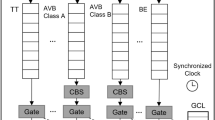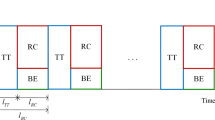Abstract
TTEthernet is a deterministic, synchronized and congestion-free network protocol based on the Ethernet standard and compliant with the ARINC 664p7 standard network. It supports safety-critical real-time applications by offering different traffic classes: static time-triggered (TT) traffic, rate-constrained (RC) traffic with bounded end-to-end latencies and best-effort traffic, for which no guarantees are provided. TTEthernet uses three integration policies for sharing the network among the traffic classes: shuffling, preemption and timely block. In this paper, we propose an analysis based on network calculus (NC) to determine the worst-case end-to-end delays of RC traffic in TTEthernet. The main contribution of this paper is capturing the effects of all the integration policies on the latency bounds of RC traffic using NC, and the consideration of relative frame offsets of TT traffic to reduce the pessimism of the RC analysis. The proposed analysis is evaluated on several test cases, including realistic applications (e.g., Orion Crew Exploration Vehicle), and compared to related works.























Similar content being viewed by others
Notes
A busy period for level L is defined by an interval [s, t) such that s and t are both idle times for level L and there is no idle time for level L in (s, t). An idle time s for level L is a time such that all frames with a priority greater than or equal to L generated before s have been processed at time s.
References
Adnan M, Scharbarg JL, Ermont J, Fraboul C (2010) Model for worst case delay analysis of an AFDX network using timed automata. In: IEEE conference on emerging technologies and factory automation, Bilbao, pp 1–4
ARINC (2009) ARINC 664P7: Aircraft data network, Part 7. Avionics full-duplex switched Ethernet network
Bauer H, Scharbarg JL, Fraboul C (2010) Improving the worst-case delay analysis of an AFDX network using an optimized trajectory approach. IEEE Trans Ind Inform 6(4):521–533
Boyer M, Fraboul C (2008) Tightening end to end delay upper bound for AFDX network calculus with rate latency FIFO servers using network calculus. In: IEEE international workshop on factory communication systems, Dresden, pp 11–20
Chang CS (2000) Performance guarantees in communication networks, 1st edn. Springer, London
Cruz C (1991) A calculus for network delay, part I, network elements in isolation. IEEE Trans Inform Theory 37(1):114–131
Cummings R, Richter K, Ernst R, Diemer J, Ghosal A (2012) Exploring use of Ethernet for in-vehicle control applications: AFDX, TTEthernet, EtherCAT, and AVB. SAE Int J Passeng Cars Electron Electr Syst 5(1):72–88
Danielis P, Skodzik J, Altmann V et al (2014) Survey on real-time communication via Ethernet in industrial automation environments. In: Proceedings of the 2014 IEEE emerging technology and factory automation (ETFA), IEEE, pp 1–8
Decotignie JD (2005) Ethernet-based real-time and industrial communications. Proc IEEE 93(6):1102–1117
ETG (2013) ETG.1000.1 EtherCAT Specification. EtherCAT Technology Group
Frances F, Fraboul C, Grieu J (2006) Using network calculus to optimize the AFDX network. In: Proceedings of 3rd European congress embedded real-time software, Toulouse, France
Fletcher M (2009) Progression of an open architecture: from Orion to Altair and LSS. White paper S65-5000-20-0, Honeywell, International
Gavrilut VM, Tamas-Selicean D, Pop P (2015) Fault-tolerant topology selection for TTEthernet networks. In: Safety and reliability of complex engineered systems: proceedings of the 25th European safety and reliability conference. CRC Press, London, pp 4001–4010
Grieu J (2005) Analyse et valuation de techniques de com-mutation Ethernet pour l’interconnexion des systmes avioniques. Ph.D. dissertation, Laboratory Space and Aeronautical Telecommunications, Toulouse, France
IEEE (2011) IEEE 802.1BA—IEEE standard for local and metropolitan area networks—audio video bridging (AVB) systems. The Institute of Electrical and Electronics Engineers, Inc
IEEE (2012) IEEE 802.3—IEEE standard for Ethernet. The Institute of Electrical and Electronics Engineers, Inc
IEEE (2015) IEEE P802.1Qbv (Draft 3.1)—enhancements for scheduled traffic, IEEE Time-Sensitive Networking Task Group. http://www.ieee802.org/1/pages/802.1bv.html
Kopetz H (1991) Event-triggered versus time-triggered real-time systems. In: Karshmer A, Nehmer J (eds) Operating systems of the 90s and beyond. Lecture notes in computer science, vol 563. Springer, Berlin, pp 86–101
Kopetz H, Grunsteidl G (2005) The time-triggered Ethernet (TTE) design. In: 8th IEEE international symposium on object-oriented real-time distributed computing, Washington DC, pp 22–33
Kopetz H (2011) Real-time systems: design principles for distributed embedded applications. Springer, Berlin
Le Boudec JY, Thiran P (2001) Network calculus: a theory of deterministic queuing systems for the internet. In: Lecture notes on computer science, 5th edn. Springer, New York
Lee YH, Rachlin E, Scandura PA (2005) Safety and certification approaches for Ethernet-Based Aviation Databuses. Technical report DOT/FAA/AR-05/52, Federal Aviation Administration
Li XT, Scharbarg J, Fraboul C (2010) Improving end-to-end delay upper bounds on an AFDX network by integrating offsets in worst-case analysis. In: IEEE conference on emerging technologies and factory automation, Bilbao, pp 1–8
Mabille E, Boyer M, Fejoz L et al (2013) Towards certifying network calculus. Interactive theorem proving. Springer, Berlin
Mauclair C, Durrieu G (2013) Analysis of real-time networks with monte carlo methods. EUCASS Proc Ser 6:501–514
Obermaisser R (2011) Time-triggered communication. CRC Press, London
Paulitsch M, Schmidt E, Gstottenbauer B, Scherrer C, Kantz H (2011) Time-triggered communication (industrial applications). In: Time-triggered communication. CRC Press, London, pp 121–152
Pedreiras P, Almeida L, Buttazzo G (2005) FTT-Ethernet: a flexible real-time communication protocol that supports dynamic QoS management on Ethernet-based systems. IEEE Trans Ind Inform 1(3):162–172
SAE (2011) AS6802: Time-triggered Ethernet. SAE International
Scharbarg JL, Ridouard F, Fraboul C (2009) A probabilistic analysis of end-to-end delays on an AFDX avionic net-work. IEEE Trans Ind Inform 5(1):28–49
Schmitt J, Hurley P, Hollick M et al (2003) Per-flow guarantees under class-based priority queueing. In: IEEE global telecommunications conference, pp 4169–4174
Schneele S, Geyer F (2012) Comparison of IEEE AVB and AFDX. In: Proceedings of the digital avionics systems conference, pp 7A1C1–7A1C9
Steinbach T, Lim HT, Korf F, Schmidt TC, Herrscher D, Wolisz A (2012) Tomorrows in-car interconnect? A competitive evaluation of IEEE 802.1 AVB and time-triggered Ethernet (AS6802). In: IEEE vehicular technology conference. IEEE Press, New York, pp 1C5
Steiner W, Bauer G, Hall B, Paulitsch M, Varadarajan S (2009) TTEthernet dataflow concept. In: 8th IEEE international symposium on network computing and applications, Cambridge, MA, pp 319–322
Steiner W (2010a) An evaluation of SMT-based schedule synthesis for time-triggered multi-hop networks. In: IEEE 31st real-time systems symposium (RTSS), San Diego, CA, pp 375–384
Steiner W, Dutertre B (2010b) SMT-Based formal verification of a TTEthernet synchronization function. Formal methods for industrial critical systems. Springer, Berlin
Steiner W (2011) Synthesis of static communication schedules for mixed-criticality systems. In: 14th IEEE international symposium on object/component/service-oriented real-time distributed computing work-shops, Newport Beach, CA, pp 11–18
Steiner W (2016) Deterministic Ethernet for real-time and critical applications. In: 12th IEEE world conference on factory communication systems, Aveiro, Portugal
Steven M, Minet P (2006) Schedulability analysis of flows scheduled with FIFO: application to the expedited forwarding class. In: 20th international parallel and distributed processing symposium
Suen J, Kegley R, Preston J (2013) Affordable avionic networks with Gigabit Ethernet assessing the suitability of commercial components for airborne use. In: Proceedings of SoutheastCon, pp 1C6
Tamas-Selicean D, Marinescu SO, Pop P (2012a) Analysis and optimization of mixed-criticality applications on partitioned distributed architectures. In: 7th IET international conference on system safety, incorporating the cyber security conference, Edinburgh, pp 21–26
Tamas-Selicean D, Pop P, Steiner W (2012b) Synthesis of communication schedules for TTEthernet-based mixed-criticality systems. In: Proceedings of the eighth IEEE/ACM/IFIP international conference on hardware/software codesign and system synthesis, New York, pp 473–482
Tamas-Selicean D (2014a) Design of mixed-criticality applications on distributed real-time systems. PhD Thesis, Technical University of Denmark
Tamas-Selicean D, Pop P, Steiner W (2015a) Design optimization of TTEthernet-based distributed real-time systems. Real-Time Syst 51(1):1–35
Tamas-Selicean D, Pop P, Steiner W (2015b) Timing analysis of rate constrained traffic for the TTEthernet communication protocol. In: International symposium on real-time computing (ISORC)
Wanderler E, Thiele L (2006) Real-time calculus (RTC) toolbox. http://www.mpa.ethz.ch/Rtctoolbox
Zafirov A (2013) Modeling and simulation of the TTEthernet communication protocol. Masters thesis, Technical University of Denmark
Zhao LX, Xiong HG, Zheng Z, Li Q (2014) Improving worst case latency analysis for rate-constrained traffic in the Time-Triggered Ethernet Network. IEEE Commun Lett 18(11):1927–1930
Acknowledgements
This study is co-supported by the National Natural Science Foundation of China (61073012 and 61301086) and the Fundamental Research Funds for the Central Universities of China (YWF-14-DZXY-023 and YWF-15-GJSYS-055).
Author information
Authors and Affiliations
Corresponding author
Rights and permissions
About this article
Cite this article
Zhao, L., Pop, P., Li, Q. et al. Timing analysis of rate-constrained traffic in TTEthernet using network calculus. Real-Time Syst 53, 254–287 (2017). https://doi.org/10.1007/s11241-016-9265-0
Published:
Issue Date:
DOI: https://doi.org/10.1007/s11241-016-9265-0




